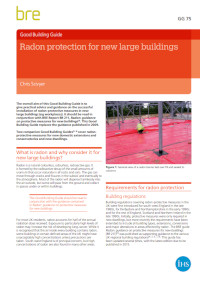Radon protection for new large buildings GG 75
BRE (Building Research Establishment) is an independent, research-based consultancy, testing and training organisation, operating in the built environment and associated industries.
Radon protection for new large buildings (GG 75 revised) was written by Chris Scivyer and published by BRE on 13 January 2015.
Radon is a natural, colourless, odourless, radioactive gas formed by the radioactive decay of the small amounts of uranium that occur naturally in all rocks and soils. It can move through cracks and fissures in the subsoil and eventually to the atmosphere. Most of this radon will disperse harmlessly, but some will collect in spaces under or within buildings.
For most UK residents, radon accounts for half the annual radiation they receive. Exposure to particularly high levels of radon may increase the risk of developing lung cancer. While it is recognised that the air inside every building contains radon, some buildings in certain areas of the UK might have unacceptably high concentrations unless precautions are taken. South-west England is of principal concern, but high concentrations of radon are also found in other areas.
Building regulations covering radon-protective measures in the UK were first introduced for south-west England in the late 1980s, for Derbyshire and Northamptonshire in the early 1990s and for the rest of England, Scotland and Northern Ireland in the late 1990s. Initially, protective measures were only required in new dwellings, but more recently the requirements have been extended to include all building types, extensions, conversions and major alterations in areas affected by radon.
This 8-page Good Building Guide gives practical advice about the installation of radon-protective measures in new large buildings (eg workplaces). It replaces the guidance published in 2009 and should be read in conjunction with BRE Report BR 211, Radon: guidance on protective measures for new buildings.
Its contents are:
- What is radon and why consider it for new large buildings?
- Requirements for radon protection and radon reduction.
- Protective measures.
- Basic radon protection.
- Full radon protection.
- Radon barriers.
- High water table and tanking to basements and cellars.
- Subfloor ventilation.
- Subfloor depressurisation and sumps.
- Monitoring completed buildings.
- References.
- Further reading.
[edit] Related articles on Designing Buildings Wiki
- BRE articles on Designing Buildings Wiki.
- BRE Buzz articles on Designing Buildings Wiki.
- BRE Buzz.
- BREEAM.
- Building Research Establishment.
- Methane and other gasses from the ground.
- Radon.
- Radon: Guidance on protective measures for new buildings BR 211.
- Radon protection for new domestic extensions and conservatories with solid concrete ground floors (GG 73 revised).
- Radon protection for new dwellings GG 74.
- Radon solutions in older homes GR 38.
- Site appraisal.
- Site investigation.
- Soil survey.
- Solid and liquid contaminants risk assessments.
- Subfloor.
Featured articles and news
Editor's broadbrush view on forms of electrical heating in context.
The pace of heating change; BSRIA market intelligence
Electric Dreams, Boiler Realities.
New President of ECA announced
Ruth Devine MBE becomes the 112th President of the Electrical Contractors Association.
New CIAT Professional Standards Competency Framework
Supercedes the 2019 Professional Standards Framework from 1 May 2025.
Difficult Sites: Architecture Against the Odds
Free exhibition at the RIBA Architecture Gallery until 31 May.
PPN 021: Payment Spot Checks in Public Sub-Contracts
Published following consultation and influence from ECA.
Designing Buildings reaches 20,000 articles
We take a look back at some of the stranger contributions.
Lessons learned from other industries.
The Buildings of the Malting Industry. Book review.
Conserving places with climate resilience in mind.
Combating burnout.
The 5 elements of seiri, seiton, seiso, seiketsu and shitsuke.
Shading for housing, a design guide
A look back at embedding a new culture of shading.
The Architectural Technology Awards
The AT Awards 2025 are open for entries!
ECA Blueprint for Electrification
The 'mosaic of interconnected challenges' and how to deliver the UK’s Transition to Clean Power.
Grenfell Tower Principal Contractor Award notice
Tower repair and maintenance contractor announced as demolition contractor.
























